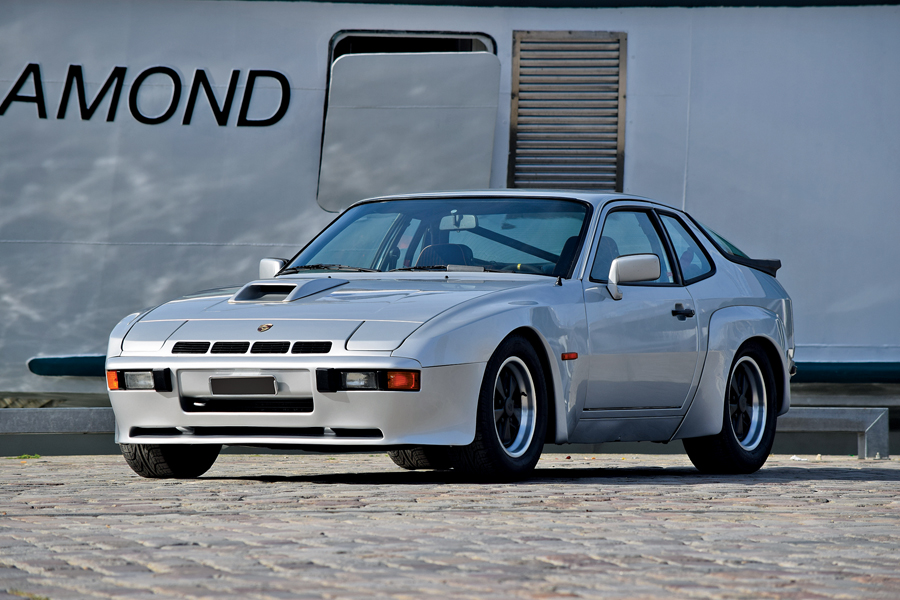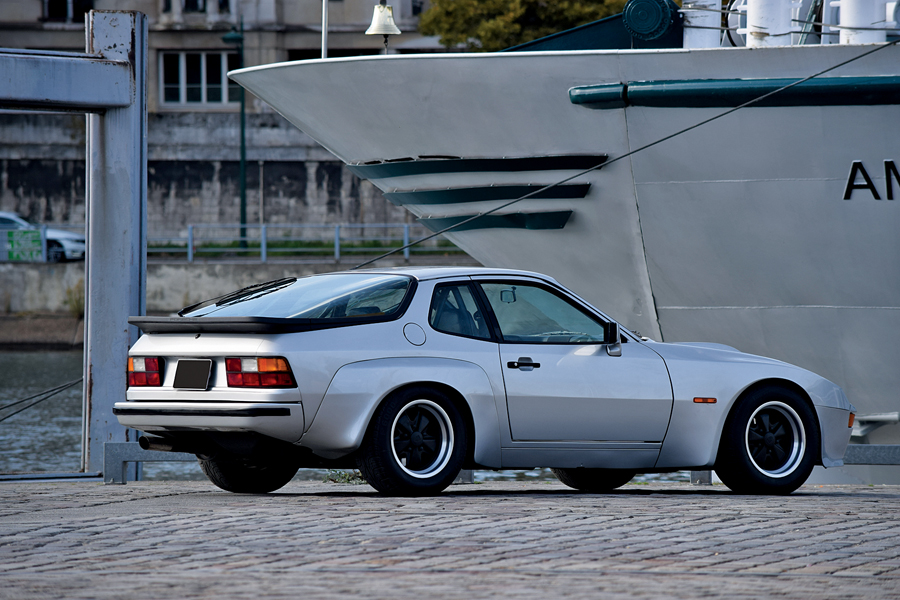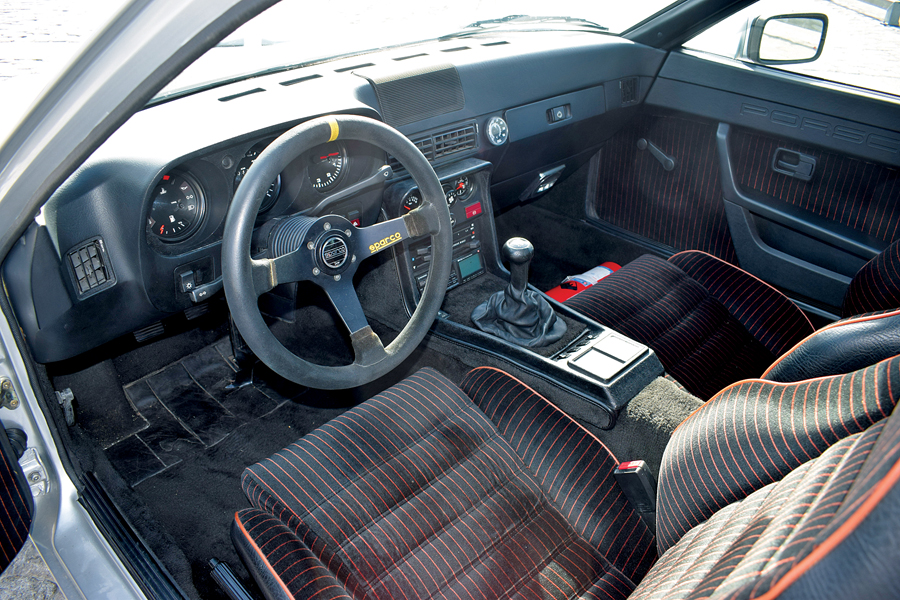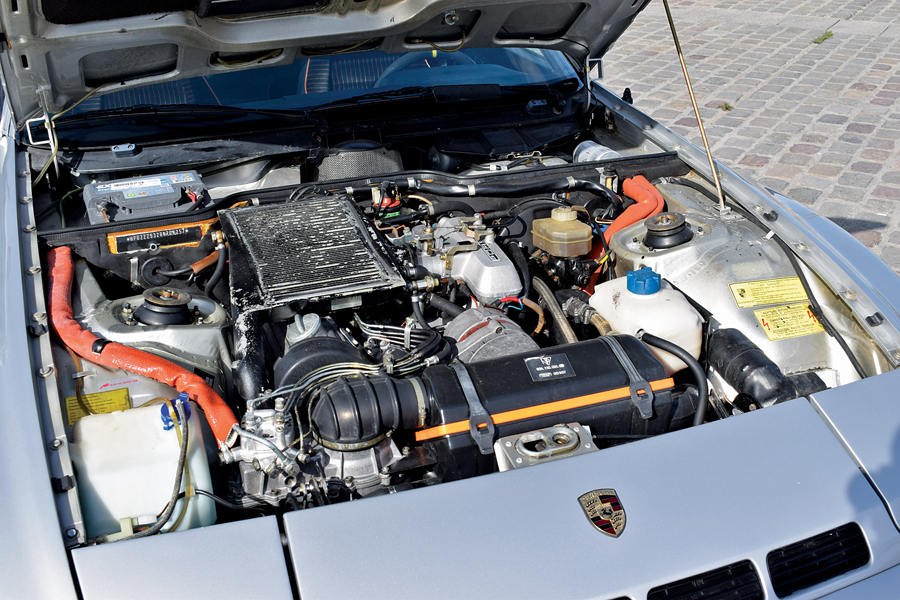- Very rare homologation model
- With service logbook and regularly maintained
- Only 406 made
- No reserve
SCM Analysis
Detailing
| Vehicle: | 1981 Porsche 924 Carrera GT coupe |
| Years Produced: | 1980 for GT, 1976–85 for the original 924, 1986–88 for the 924S |
| Number Produced: | 406 Carrera GTs, 121,300 924s, 11,600 924 Turbos, 16,700 924Ss and about 101 race car specials |
| Original List Price: | Approximately $26,000 |
| SCM Valuation: | $71,934 |
| Tune Up Cost: | About $2,000 because of double injectors; $5,000 major service with belts |
| Chassis Number Location: | Stamping on vertical engine compartment bulkhead, passenger’s side, in front of water bottle; aluminum tag on horizontal bulkhead next to water bottle, passenger’s side |
| Engine Number Location: | Stamped on engine block where bellhousing bolts in, below ignition-coil mount |
| Club Info: | Porsche Club of America |
| Website: | http://www.pca.org |
| Alternatives: | 1975–78 Datsun 280Z; 1975–83 BMW 320; MGB; 1976 Capri II |
| Investment Grade: | C |
This car, Lot 66, sold for $58,360 including buyer’s premium, at Artcurial’s Paris, France, auction on November 5, 2017.
The Porsche 924 GT is an underappreciated, attractively priced collector car, and it has an interesting development history that included some of Porsche’s best engineers. It is also relatively scarce — especially in the U.S. — and a solid performer.
For 1977, the 924 was Porsche’s new entry-level car, replacing the 914/4 and the one-year-only 912E.
In those days of reoccurring financial duress, Porsche looked to joint ventures with cousin companies for their entry-level cars. Volkswagen manufactured the 914. For the 924, Audi provided the engine and gearbox and VW did the stamping and assembly.
That downscale association with Audi and VW always hurt the public perception of these models. The 911 crowd never accepted the cars as “real” Porsches, although they developed their own fan bases. Almost 116,000 914/4s and almost 133,000 924s were built — not bad for orphans.
Enthusiasm for both the 914 and 924 emanated from the cars’ enhanced drivability, as both offered better balance than rear-engined 911s, with their inherent trailing-throttle oversteer.
Cheaper interior materials, a “tinny” feel, and non-Porsche engines were the primary detractions.
In the case of the 924, the Audi 1,984-cc inline 4-cylinder powerplant, even with a Porsche-designed cylinder head, compared favorably only with most tractor engines. The Bosch K-Jetronic-fed unit developed 125 horsepower in Euro spec — but only 95 in U.S. trim. Horsepower was raised to 110 when the initial U.S. smog equipment became obsolete.
The Audi 4-speed gearbox also was perceived to be a step backwards, as was the combination of front disc and rear drum brakes. A 5-speed gearbox option was introduced for 1979.
However, because of the handling advantages of a 48% front, 52% rear weight distribution, Porsche undertook 924 development projects.
One project led to the 924 DP — built 16 strong — a U.S. kit-car race car designed for the SCCA D Production Class. In Al Holbert’s car, Doc Bundy won the National Championship in 1980. Another project created the 924 Turbo with power bumped to 170–177 horsepower (only 143–149 in the U.S.). Road testers loved it and buyers followed.
The base for a race car
The Carrera GT development program was undertaken to prepare the 924 to race in FIA Group 4, IMSA GTO and SCCA C Production Class. Homologation rules called for building 400 base cars in one year.
The prototype 924 GT was shown at the 1979 Frankfurt Auto Show to gauge public reception. Engineers cut its weight by 330 pounds vs. the 924 Turbo. The car weighed about 2,460 pounds, growing to 2,590 pounds in the production version. The visual changes included wide polyurethane front fenders, big tacked-on rear flares, aluminum hood and aluminum door skins (fiberglass in production cars), stripped interior, front air dam and a bigger rear-lip spoiler.
Underneath one found uprated Bilstein shocks and coil-overs, larger four-wheel disc brakes and tires, and a more developed M51/30 engine that delivered 210 horsepower and 203 foot-pounds of torque from a new crankshaft, new pistons, an intercooler, and a head that featured an 8.5:1 (unboosted) compression ratio. The 5-speed G51 gearbox was standard.
Press and pubic reactions were favorable, and the 924 Carrera GT was introduced to Europe in June 1980 at a price equivalent to about $26,000. The car was not sold in North America.
The GT hit 0–100 km/h (62 mph) in 6.9 seconds with a top speed of 150 mph. Porsche built 406 examples by December 1980, although it took another year to sell them all.
The Carrera GT homologated some very special cars
To fully appreciate the Carrera GT, it helps to review the street and race cars that it spawned: the GTS, the GTS Club Sport, and ultimately, the GTR and GTP.
The next step in the homologation process was the GTS, which required 50 examples. It was a streetable performance car, not too far up the food chain from the Carrera GT. It developed 245 horsepower and 247 foot-pounds of torque, delivered a 0–100 km/h (62 mph) time of 6.2 seconds, with a top speed of 155 mph. The suspension was refined, and 911 Turbo brakes were used. Special seats were installed in an even more stripped interior.
The car’s weight was back down to 2,470 pounds. The price was about $56,000. The GTS Club Sport accounted for about 15 of the 59 units. It had a full Matter aluminum roll cage, 935 “lollipop” racing seats, often no rugs at all, plexiglass windows with fore and aft sliders for the doors and some suspension and engine-tuning tweaks.
Four cylinders, two liters and 375 horsepower
Then came the 17–18 GTRs and four GTPs – specifically outfitted for race and rally. They were stripped down to about 2,100 pounds, or 2,200 pounds in Le Mans endurance-racing trim. The rally-spec engine delivered 280 horsepower, while the road-race version twisted as high as 375, with 300 foot-pounds of torque. That one delivered 0–100 km/h (62 mph) in 4.7 seconds and a 180-mph top speed. That level of performance would set you back about $86,000.
The four Le Mans versions, built by Porsche Racing chief engineer Norbert Singer, were called GTPs, and they were even more radical. They had 14-point welded roll cages designed specifically to overcome every weakness in the GTS’s torsional rigidity, and 935-derived suspensions. Porsche entered three teams for Le Mans in 1980. The healthy car of Jürgen Barth and Manfred Schurti finished 6th overall while the other two, both down a cylinder, came in 12th and 13th.
Just to bring the circle complete, we should mention the seven Dave Klym — aka Fabcar-built — U.S.-raced GTRs. They were purpose-built racers and successful for a short time in SCCA, IMSA, and Trans-Am. Those custom-made, very tightly wound cars had about four real Porsche parts on them — roof, windshield, hood decal, and valve cover embossed with “Porsche.” They were bullet-fast but required a full-time, highly skilled mechanic just to keep them idling.
A homologation special for under $60,000
Now, let’s get back to the silver 1981 924 Carrera GT at Artcurial’s auction. It was first registered in December 1981 out of the Lausanne, Switzerland, dealer. It had a complete maintenance book supporting 110,000 km, about 68,200 miles, with some regional competition in rallies and hillclimbs. A roll bar and competition belts had been added. The car looks to have been fully repainted and the interior showed use. It was not reported to have had a wreck, but only an inspection would have told us with certainty.
Artcurial presented the car with no reserve. It sold for $58,360 including the buyer’s premium.
Assuming there were no hidden issues, you had a presentable Porsche homologation special that would be a lark to drive for under $60,000. A 924 GTS would cost you about $300,000 — and a Club Sport would run up to $400,000. A GTR is a lot more and a Le Mans GTP might approach $1,000,000.
The value-per-hour of wide grins highly favors the Carrera GT. ♦
(Introductory description courtesy of Artcurial.)



